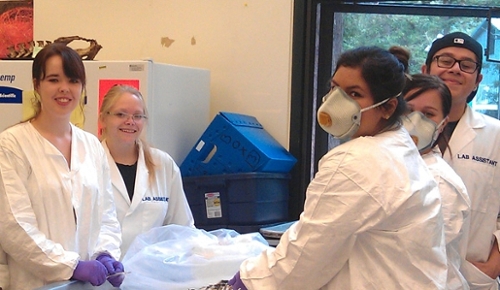Learning on the Cutting Edge
by Abel Rivas, Class of 2014
A few years ago, I started worshipping bones. I was coming out of my first lab when I spotted a flyer with a crafty skeleton near the elevator. I remember being tempted in taking the flyer home so I could cut out the skeleton to add it to my collage. I looked around me to see if anyone was looking; I was ready to take it home. I remember thinking: “Victory is mine!” Without even placing a hand on it, I started feeling guilty and instead I read it. That was the actually best decision I could have made because it led me to contacting Richard Baldwin. Richard directs a lab tutorial course designed for students interested in learning the principal functions inside the anthropology labs—learning about proper protocols, biohazardous wastes, cataloging skeletal material, 3-D scanning, dissections, and much more. It is a valuable course because students learn skills that can be applied inside and outside anthropology.
A few weeks later, after the course had started, he said to me, “let’s go to the anatomy lab.” Dun, dun, dun, the anatomy lab! I did not think he was taking to me to the lab to degrease recently dissected material. Neither did I expect to observe the human cadavers or dissect them, but I simply did not know what to expect. Since that first time inside the anatomy lab I have degreased, dissected, catalogued cadavers, and also been inside the freezer room. After the quarter ended, I was away from the labs for a few months. Later that year, I started volunteering inside the anatomy labs by merging the new and original skeleton collection into a new room. Eventually, I asked Richard if I could dissect any- thing from the freezer room because I wanted to practice my dissection skills. We went into the anatomy lab, and we started dissecting a bird. He gave me a one-on-one lesson that I found extremely useful because I needed practice and I did not know which field of anthropology I wanted to pursue.
After that time, I began dissecting other specimens, including my personal favorite, a coyote. I believe the coyote was found dead on the road, and a graduate student brought it to the lab to have all soft tissues removed to study its teeth for isotopic analysis. I also remember dissecting this coyote because I was leading a dissection tutorial. Two of the students inserted their blades incorrectly and I remember seeing myself in their shoes when I first started dissecting. I gave another demonstration and since my blade was no longer sharp, I asked one of them to replace my blade. The goal was to make sure they felt comfortable using a scalpel—since that is one of the main skills to practice in the tutorial course. They learned and felt comfortable using scalpels, and I could tell once they would start talking about their classes or something on television. That is how I actually met some of my closest friends.
My friends and I would think about which classes we should take next quarter, perhaps forensic anthropology, paleopathology, or something totally different. This quarter I am finishing my first molecular anthropology course, which is extremely different from studying human bones or human diversity. Molecular anthropology is mostly a genetic based course, so our course applied the different lab methods that our discipline adopts from biology and forensic labs. For example, replicating and purifying our DNA and using genetic browsers to figure out what our DNA can tell us about our class group versus population genetics. The course was also seminar based, so I was assigned a reading on European impact on Native Americans. It was interesting to read how by tracing mitochondrial DNA, molecular anthropologist Fehren-Schmitz and his colleague O’Fallon were able to reconstruct a demographic population decline just as the historical narrative we have learned in anthropology. Professor Fehren-Schmitz has been incredibly patient and helpful throughout the course and gave us the chance to practice these methods that are relevant in anthropology. Someday I hope to pipette like him—he is, like, a Jedi Master in pipetting, and I am one of his Padawans. I am humbled by everything I have learned and grateful that I was able to meet staff members that cater to students’ interests. I am not entirely sure which direction I am going this summer, but I have found a passion, and I have gathered a set of tools that make me a stronger applicant for graduate school or a job.

